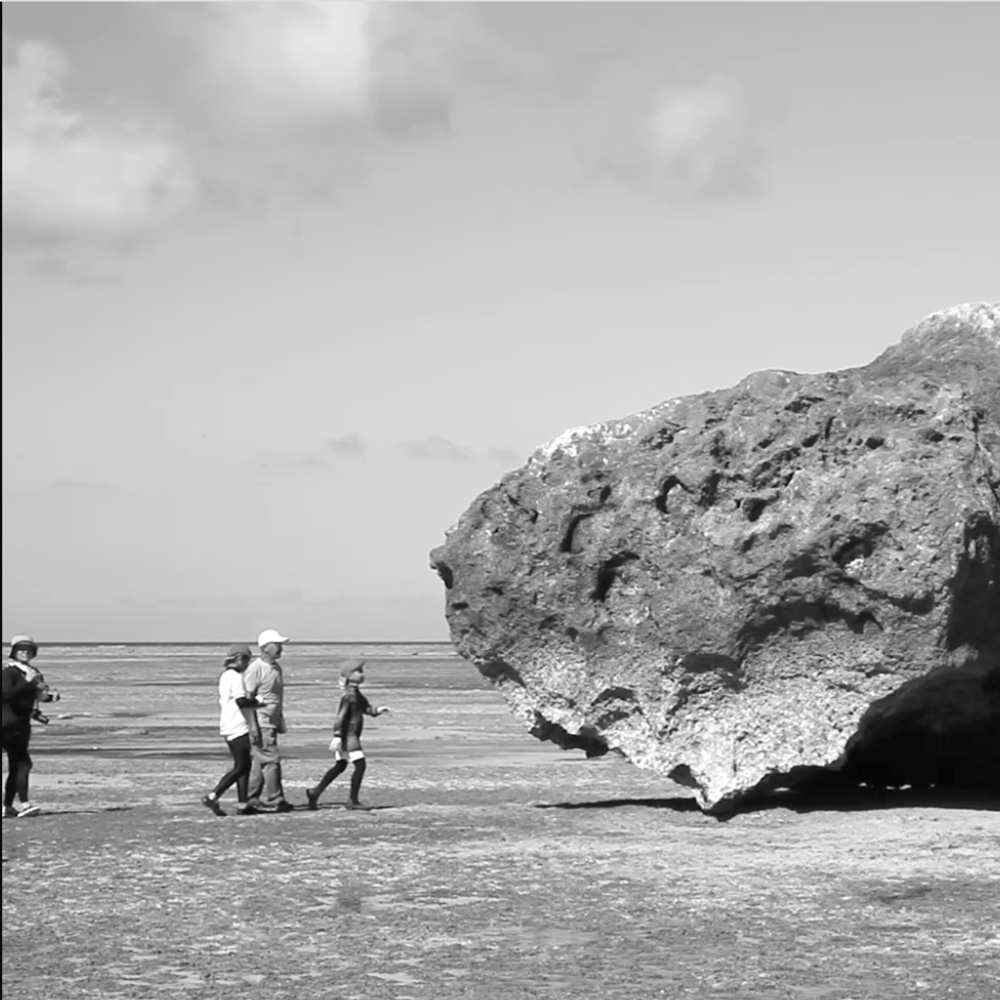-Followed by English translation-
下道基行は、記憶の共有のされ方を問いながら、歴史環境と他者との出会い、そして自らの主観がせめぎあう地点から生まれる痕跡を収集し続ける。大局的な立ち位置を俯瞰しつつ、日常を越えたスケールでの移動を繰り広げながらも、実際の彼の行動は出会う他者からの個別の働きかけに応じるものだ。そうして、物語の叙情に流されることもなく、イデオロギーの煽情に翻弄されることもなく、異なる立場や文脈を持つもの同士が、ちょうど均衡する手応えを探ったところで立ち止まる。共有されるべきモニュメントから固有の意味を引き剥がし、人々の中に流通する物事の生きた記憶の欠片を拾って歩くのだ。そして再び、それを新たな機能と因果の中に置き直すのである。
彼の手法は、場所を超えた共時性、時間を超えた場所の変化、個別なものと共有可能なもの、相反する条件を複合的に組み合わせることに特色がある。そして、それを精錬されたシンプルな軌跡に落とし込んで提示するのだ。彼の初期の活動として知られる「戦争のかたち」シリーズでは、日本全国にちらばるトーチカや掩体壕などの戦跡を撮影した。遠い歴史が別の機能を与えられている風景の再現だけでなく、現地の人々の聞き込みなどから、生きたノイズのある記憶の温もりのようなものを手掛かりに旅程を進む。あるいは、Re-Fortプロジェクトのように、場を再利用し人が交流できる出来事を生み出したりする。それがカウンターモニュメントと異なるのは、戦争の記憶の再認識を促すわけではなく、別の目的を持ったプロジェクトの進行の場としてしまうことである。大きな構造である歴史の集積と、小さな関係性に基づく記憶を辿る作家の二面性は、ときには「A面―B面」として形容された。(註10)『torii』写真集では、記号同士の視覚性は強まり、一種の類型学の体を成している一方、日本の外のかつての外郭を辿る旅であるが故に、よりプロセスの不透明さと不確実さは増すことになった。作家が進む時間に伴い、撮影日記から垣間見えるのは、国境線の移動によって同じ場所に居ながらにして異文化の浸透を余儀なくされた人々が、混在し共生する物語でもある。近年作家はプロセス重視的なあるいは私的な領域の作品が強くなってきているのであるが、美術館や国際展などの公的な場所で発表する機会が増えていることへの反動であろうか。
今回沖縄では、検索システムと実際の出会いから生まれる文脈を相互に辿りながら、物質の収集というアプローチを作家は採用している。境界をはさんでせめぎ合う他者の歴史が閉じ込められた民具やガラス瓶、海水を、地域の実際の生活に近いところで収集した。写真撮影という手段を取らなかったのは、出会いのあり方や体験の強度がより重視されているからだろう。一瞬で撮影され、消費され、複製される画像情報よりも、物質と文字によって間接的に体験を置き換えることを望んだのだ。よって収集物はスーベニールのような趣を持つ。それは、全体の一部しか示唆せず、不透明であり一回性の体験そのものの「額縁」として永続的に記憶を下支えする。 (註11) こうして集められた収集物は、作家個人の体験認識的な小宇宙を構成する「驚異の部屋(Wunderkammern)」のようでもある。
大きな構造の欠片が溶かされ混ざり合ったモニュメントは、宙吊り状態のまま、可変することを前提に空間に設置されている。冷蔵庫、保存ケース、標本箱、といった装置によって、人々の間で取り交わされていた生々しい温度と物質一枚隔て、我々の前に提示される。まるで時間の断絶とずれを保存するタイムカプセルのようである。彼が旅人であるいうことは、複数の場と状況を組み換えながら、現実世界に対応していくことであり、それは、写真集編集や標本採集、多様なフォーマットを駆使し横断しながら、アウトプットを続ける表現上の活動に似ている。いかなる場所も、いかなる媒体(メディア)も相対的なものに過ぎず、周囲や前後の作品と相対的な関係によって決定される。収集すること、共働すること、そしてそれを提示すること、それは、日常の中に隠されたある一瞬の断面を探すことだ。そしてあまりにも日常と地続きの行為であるがゆえに、フレームで時間と場所を切り取り、ずらしながら、アートと社会のささやかな段差を作ることが必要だったのかもしれない。
土方浦歌(キュレーター)
10.服部浩之「A面とB面、そしてそれらを結ぶ余白の物語」作家HPからhttp://m-shitamichi.com/
11.津上英輔「Souvenir ―観光体験の額縁」西村清和編『日常性の環境美学』勁草書房、2012年、p.244
:::::::::::::::::::::::::::::::
Motoyuki Shitamichi pursues a way of sharing common memories, collecting the traces where the subject encounters grand history and the environment, and they are intermingled each other. From a distance he thinks in a unique perspective to general situation but in fact he reacts responding to every agencies that he encounters. Then, without any romanticism or any message of ideology, he takes a neutral stance between those with opposing and contentious views. He eliminates the particuler meaning of the monument and picks up the pieces of living memory that circulates in people. So doing, he replaces them with new functions and causal relationships.
It is his distinguished approach to combine conflicting criteria of synchronicity over different locations and changing times in the same location, to establish whether something is to be shared or belongs to individuals. He presents such tracks in refined and simplified composition. In his early career, the bunkers series consisted of photos taken in the ruins of military architecture, bunkers and pillboxes that remain throughout Japan. Not only did he reproduce the landscape to give it another function, he engaged with the local people, and completed his itinerary with the sounds and warmth of the people.
On the other hand, the Re-Fort project was a compilation of the recollections that people shared during a meeting in the same war ruins. His attempt differs from the Counter Monument: he does not evoke the beholder by a visual memory of war, he alters the progression of the event according to others’ memories. This dual aspect artist, tracing both the grand structure that is integrated into history, and tracing private relationships with others, is often described as “side A and side B”.(n.10) In torii photo-books, the symbolic visual aspect looks stronger. It is the typology, and therefore the journey following the former contour of the outside of Japan, that is supposed to increase the sense of uncertainty. In the artist’s diary, with the progression of time, we can glimpse the narrative story of people who lived around the national border where they were forced to coexist with different cultures who had penetrated the border. In recent years, because the artist has had increasing opportunities to exhibit in museums and internationally exhibitions, it seems slightly distinguish since he works in the private field and process oriented activities.
During the sojourn in Okinawa, his research did not include photography even though he is primarily known as a photographer. He did online research and tried to create context by collecting materials. He sampled seawater, collected glass bottles and duralumin from living scenes. In local residences, he sampled fragments of historical evidence on the opposite side of the border. He did not adopt the approach of taking photos, probably because he wanted to emphasis the intensity of the experience. Photos are taken in a moment, the image data, once copied and reproduced is wasted rapidly, and the experience of the event is fleeting.
He wanted to represent the experience in this indirect way by material and words. These collected objects have the character of souvenirs. It suggests only a part of the whole and preserves the memory permanently stored as a frame that capture the moment of the transition experience.(n.11) Thus, the collection constitutes a microcosm of personal experiences like a ‘Cabinet of curiosities (Wunderkammern)’.
Monument fragments of big structures were mixed and suspended in the air, refrigerators, storage cases, specimen boxes and other devices separate the beholders from objects that used to actively be exchanged among people. It is like a time capsule where we save the distortion and disconnection of time.
He is a constant traveler. He experiences the real world as he edits photo books and samples specimens: he makes full use of his experiences as he would make full use of various formats. Any location or any medium (media) is also only a relative aspect for him that is determined by the relative relationship with a stretch of time. In his collections, he looks for hidden details in everyday life to portray. He engages these acts without delimiting his surrounding life, therefore it is required to frame one scene of everyday life and displace it to another site. Furthermore, he needs to make a modest gap of the stages between art and society.
Uraka Hijikata(curator)
10. Hiroyuki Hattori, “A-side and B-side Story of what is in between the two sides”, Artist HP
http://m-shitamichi.com/
11.Eisuke Tsugami,”Souvenir-frame of the experience in tourism” , Kiyokazu Nishimura(edit), Aesthetics in daily Environment, 2012, p.244
